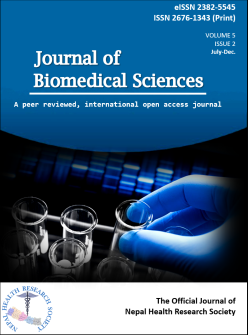Cell signaling in yeast: A mini review
DOI:
https://doi.org/10.3126/jbs.v5i2.23634Keywords:
iron, magnesium, malaria, micronutrients, zinc, copperAbstract
Background: Understanding cellular mechanism of communication is the main goal of systems biology. Unicellular yeasts are effective model to understand the molecular interactions that generate cell polarity induced by external inputs. The mechanisms of many extracellular stimuli are induced by complexes of cell surface receptors, G proteins. The mechanisms of many extracellular stimuli are induced by complexes of cell surface receptors, G proteins and mitogen activated protein (MAP) kinase complexes. Many components, their interrelationships, and their regulators of these mechanisms were initially identified in yeast. A complex web of sensing mechanisms and cooperation among signaling networks such as a cyclic adenosine monophosphate dependent protein kinase, mitogen-activated protein kinase cascade and 5-adenosine monophosphate activated protein kinase induce various changes in physiology, cell polarity, cell cycle progression and gene expression to achieve differentiation. Ras-cAMP pathway explained in yeast model with signalling function of the oncogenic mammalian Ras protein. So studies on yeast cells may enlighten some underlying mechanism which will be beneficial to understand the mechanisms of disease.
Downloads
Downloads
Published
How to Cite
Issue
Section
License
This license enables reusers to distribute, remix, adapt, and build upon the material in any medium or format, so long as attribution is given to the creator. The license allows for commercial use.




